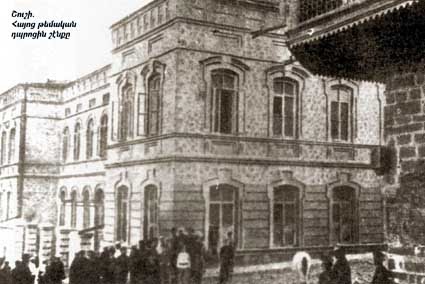Shushi was not just the capital of Artsakh until the horrendous massacre of its Armenian population organized by the first Republic of Azerbaijan in March 1920. It was also the main Armenian cultural and educational center in the South Caucasus after Tiflis (Tbilisi) and Baku, being the most important in the territory of Eastern Armenia.
The Diocesan School of Shushi was inaugurated by Catholicos of All Armenians Nerses V Ashtaraketsi on June 22, 1838, with 20 students. However, its financial situation was far from being satisfactory, and as a result, the first teachers worked unpaid.
Given this situation, Catholicos Nerses V was forced to close the school in November 1852, but managed to reopen it three years later, in November 1855. The Diocesan School was handed in 1860 to a board elected by the public, which succeeded in improving its financial situation. This was the sole boys’ secondary school of the diocese, and was maintained through donations, church income, and tuitions.
The school undertook many changes when Catholicos Mateos I, the successor to Nerses V, designated Petros Shanshian, the former principal of the Nersisian School of Tiflis. Shanshian had writer Perch Proshian as assistant and teacher of Armenian language, literature, and history. The efforts by Shanshian and Proshian resulted in the school’s flourishing. It became a nine-year school and was renamed Yeghishian National Religious School, after the name of Yeghishe, the fifth-century Armenian historian. In 1870, the student body amounted to 158, reaching the figure of 492 by 1893.
Among the famous graduates of the school were writer Muratsan (Grigor Ter Hovhannisian, 1854-1908), historian Leo (Arakel Babakhanian, 1860-1932), Archbishop Garegin Hovsepiants (future Garegin I, Catholicos of the Great House of Cilicia, 1867-1952), revolutionaries Nikol Duman (Nikoghayos Ter Hovhannisian, 1867-1912), Aram Manukian (Sergei Hovhannisian, 1879-1919), and Ishkhan of Van (Nikol Poghosian, 1883-1915).
In 1903, the school was closed by the decree of the Czarist government confiscating the properties belonging to the Armenian Church. Its faculty and students were active participants in the popular outcry against the decree, which ended triumphantly with the return of the properties throughout the empire and the reopening of the school in the fall of 1905. Teachers and students also played an important role in the Armenian self-defense during the Armeno-Tatar conflict of 1905-1907. The school was renovated by principal Avetik Ter Poghosian in 1908-1910, when the number of students was 374. It became a full high school in 1917. However, as no Armenians were left in Shushi after the massacre of 1920 by the Azerbaijanis, the Diocesan School ceased to exist.

